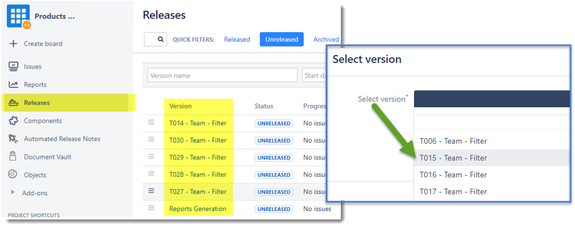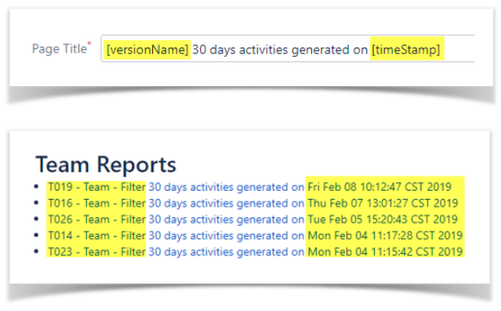Community resources
Community resources
Community resources
From Jira to Confluence with few clicks and BOOM x 15! (Part 2)
This is the second part of the Article that I wrote to explain how you can maximize the use of your Atlassian Marketplace apps to increase the Return on Investment and to facilitate the purchase approval process. I used as example one app called Automated Release Notes for Jira and while I explained how to use it, I was identifying hooks that you could use to increase the number of users accessing the app. In this Second part, my focus will be on additional tricks to use the app for more than the original designed scope.
Some tricks to extend the use of this Jira app
-
Jira Query Languages (JQL) statements and filters
-
Maximize the power of the templates by adding JQL statements and use filters if needed. Test JQL and filters in the Jira Issue Navigator and then replace it with the ARN Variables.
-
Consider the use of variables as parameters in your template JQL like projectID or versionName
-
-
Expanding the use of versionName parameter
-
To trigger a rule you will need to pick at least one version, despite it is used or not in the template. So, if you are generating an Activity report with a JQL statement like the ones below where the variable versionName is not used, you can select any version just to trigger the rule, but the selection won't be considered at all and the reports will be generated in Confluence solely based on the JQL statement
-
project=[projectId] and resolved >= startOfDay(-30d) ORDER BY IssueType (to obtain all the issues
-
filter = "T006 - Team - Filter" and resolved >= startOfDay(-30d) and issuetype in (Bug, Escalation,Epic,Task,Story) ORDER BY issueType
-
-
I am assuming that in these scenarios you will try to trigger the same rules multiple times to generate your monthly or weekly reports. If that is the case you will need to pay special attention to the variables used on the page name.
-
[projectName] 30 days activities generated on [timeStamp] where projectName will be always the same but timeStamp will change every time the Rule is generated, this only addition to your page name will avoid the error and it will allow the generation of multiple pages.
-
-
3. One rule and one template for all teams reports
-
Let's say that you are managing multiple teams (30) and you want exactly the same monthly report for each one of them stored in one location, but you don't want to generate 30 actions pointing to 30 different parent pages and you have a Jira project to manage your area where you have full admin access. In addition, you would like to have a choice when the report needs to be generated and eventually generate just a few of them.
-
Here is the trick
-
Create a version with each filter name (e.g. "T006 - Team - Filter" - the same filter that contains the projects and that it is used to create team boards)
-
Change the JQL using filters, but instead of having the name of the filter there, enter the versionName variable. Remember that you need to pick a version to run the rule.
- The new JQL statement will look like this: filter = "[versionName]" and resolved >= startOfDay(-30d) and issuetype in (Bug, Escalation,Epic,Task,Story) ORDER BY issueType
- Run the manual rule and select the name of the team that you need and voila! your team monthly report is generated in your report space.
-
The page name template field includes the variables versionName and timeStamp as parameters, so you need to be careful with the name given to the filter.
Conclusion
Bottom line, we have a choice in how we would like to go from Point A to Point B. I mentioned at the beginning that we are familiar with the Option A, my recommendation would be to try option B and spend more time with your team producing great products and having fun!
By learning how to use this app you will be able to:
- Without effort, and when a new version is released, generate multiple types of Release Notes: For management, technical teams, marketing, sales, Board of Directors, etc. All of them with their own template and information and triggered at the same time creating pages in Confluence with labels that could help with reports and including Confluence pages macros to magnify the quality of the pages.
- At the same time, you will be able to send customized emails to key stakeholders
- Both options above are the natural use of this app, but with a little bit of imagination you could do more, like:
- Create templates for products reports in a given time
- Report team activities based on filters
- Use any information captured in Jira to generate content in Confluence (Note: once the page is generated it won't be connected to Jira as using Jira Macro, the hyperlink will be active but the page it will look like a time snapshot, this is ideal if you would like to generate like a Release Plan and then a Release Report when the version is finally released)
- If you read the vendor documentation, please verify the version in use, as they have different features between Cloud and Server. In our instance, we are using Server. One of the new features in Cloud that is not included in Server is the Stats section, basically the same as the JQL section but returning the total numbers of items instead of the actual content of each issue. It is a great feature to generate reports top section with a Summary, Like Sprint results with the total numbers of Stories, bugs, etc.
I really recommend to try the Option B, you already know option A...
I hope this two-part article provides some ideas in how you can see beyond the description of the app on the marketplace to find ways of adding more users to the application. It is already paid for all of them, try to see how to involve the whole team to generate a comprehensive experience and a compelling reason to invest in the purchase of the app. Be sure that you clearly document any additional usage of the app and train your team accordingly. My best wishes on your Marketplace treasure hunt, there are many hidden gems to be discovered.
To close this article I would like to disclaim that I don't have any commercial affiliation with the developer of the app and what I wrote is based on my experience using the product, please let me know if you find any mistake so I can correct it as soon as possible. And please, don't go without checking this video created by Atlassian to promote one of the previous releases of Jira. Enjoy!!!
Learn more about Jira and Confluence together in this section of the Atlassian documentation.
Was this helpful?
Thanks!
Fabian A. Lopez (Community Leader - Argentina, Florida, California)

About this author
Project Manager Professional/Scrum Master/CTSM/ACP-CA
Document Storage Systems (DSS, Inc.)
Lake Elsinore, California
1 accepted answer
Atlassian Community Events
- FAQ
- Community Guidelines
- About
- Privacy policy
- Notice at Collection
- Terms of use
- © 2025 Atlassian











6 comments